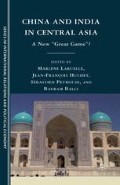Abstract
The assertion that Central Asia has become a field of economic competition between China and India is based on a prospective approach. The potential of the two countries is indeed to be competitive, but economic realities show that it is not the case at the end of the first decade of the twenty-first century. Comparisons between India and China in Central Asia, though legitimate in the geopolitical logic of power projection, is less relevant in the economic realm, the comparison being valid only over the medium or long terms, 2020 to 2030. Indeed, for the time being, except for hydrocarbons, where the Indian and Chinese companies have already come to terms, China largely dominates all the other areas. A comparison of trade flows shows that the total trade between China and Central Asia exceeded 18 billion euros in 2008, whereas between India and Central Asia, it was only 247 million euros, or 1.37 percent of that of its competitor (see table 11.1). India is the sixteenth most important trading partner for Uzbekistan and the twenty-second for Tajikistan, while China is almost always in the top three with Russia and the European Union. It is the largest trading partner of Kyrgyzstan, the second largest of Uzbekistan and Tajikistan, third for Kazakhstan, and seventh for Turkmenistan, a figure expected to rise in 2010–2011 with the arrival of the first flow of Turkmen gas to Xinjiang.
Access this chapter
Tax calculation will be finalised at checkout
Purchases are for personal use only
Preview
Unable to display preview. Download preview PDF.
Notes
Sh. Shuja, “China’s Energy Needs and Central Asia”, National Observer, Council for the National Interest, Melbourne, 67 (2006), pp. 56–65.
D.L.O. Hayward, “China’s Oil Supply Dependence”, The Journal of Energy Security, June 18, 2009.
Planning Commission; Government of India, Tenth Five-Year Plan (2002–2007), quoted in V. Kumar Bhatia, “India-Kazakhstan Relations: Challenges and Prospects”, Mainstream, vol. XLVII, no. 38, September 5, 2009.
S. Peyrouse, “Chinese Economic Presence in Kazakhstan: China’s Resolve and Central Asia’s Apprehension”, China Perspectives, no. 3, 2008, pp. 55–75.
J. Šír, S. Horák, “China as an Emerging Superpower in Central Asia: The View from Ashkhabad”, The China and Eurasia Forum Quarterly, vol. 6, no. 2, 2008, pp. 75–88.
S. Moore, “Peril and Promise: A Survey of India’s Strategic Relationship with Central Asia”, Central Asian Survey, vol. 26, no. 2, 2007, pp. 279–291.
R. Dwivedi, “China’s Central Asia Policy in Recent Times”, The China and Eurasia Forum Quarterly, vol. 4, no. 4, 2006, pp. 139–159.
Irina Komissina, “Will India Become a Full-fledged Participant in the Big Game in Central Asia?” Central Asia and the Caucasus, no. 1, 2008.
See F. Starr (ed.), The New Silk Roads: Transport and Trade in Greater Central Asia (Washington: Central Asia-Caucasus Institute, 2007).
S. Peyrouse, “The Economic Aspects of the Chinese-Central-Asia Rapprochement”, Silk Road Papers (Washington: Central Asia and Caucasus Institute), September 2007.
S. Peyrouse, “The Growing Trade Stakes of the Chinese-Kyrgyz-Uzbek Railway Project”, Central Asia and Caucasus Analyst, March 11, 2009.
S. Peyrouse, “The Hydroelectric Sector in Central Asia and the Growing Role of China”, The China and Eurasia Forum Quarterly, vol. 5, no. 2, 2007, pp. 131–148.
V. Vucetic and V. Krishnaswamy, Development of Electricity Trade in Central Asia-South Asia Region (Washington: World Bank, 2005).
World Bank, Central Asia Regional Electricity Export Potential Study (Washington: World Bank, December 2004), p. 35.
G. Sachdeva, “India”, in F. Starr (ed.), The New Silk Roads: Transport and Trade in Greater Central Asia (Washington: Central Asia-Caucasus Institute, 2007), pp. 335–382.
E. Koolaee, M. Imani Kalesar, “India’s Energy Security toward the Caspian Sea Region: A Critical Review”, The China and Eurasia Forum Quarterly, vol. 8, no. 1, 2010, pp. 83–94.
Kuchins, T. Sanderson, D. Gordon, The Northern Distribution Network and the Modern Silk Road (Washington: CSIS, December 2009).
R.M. Levine, G.J. Wallace, “The Mineral Industries of the Commonwealth of Independent States”, in 2005 Mineral yearbook (U.S. Geological Survey, 2007).
S. Peyrouse, “China’s Recent Advance in Central Asia”, Central Asia and Caucasus Analyst, December 12, 2008.
S. Smirnov, “Kazakh Metallurgy under the Control of International Corporations”, Kazakhstan International Business Magazine, no. 2, 2008, <http://www.investkz.com/en/journals/56/467.html> (accessed November 4, 2009).
S. Shmidke, “Atomnaia promyshlennost’ Kazakhstana: Sovremennoe sostoianie i perspektivy razvitiia”, PIR center, 2006, <http://www.pircenter.org/data/publications/06-05-3lShmidke_Article.pdf>.
B. Kaminski, G. Raballand, “Entrepôt for Chinese Consumer Goods in Central Asia: The Puzzle of Re-exports through Kyrgyz Bazaars”, Eurasian Geography and Economics, 2009, vol. 50, no. 5, pp. 581–590.
V. Paramonov, A. Strokov, Ekonomicheskoe prisutstvie Rossii i Kitaia v Tsentral’noi Azii (Central Asian Series, Conflict Studies Research Center, Defence Academy of the United Kingdom, Shrivenham, 07/12, 2007), p. 5.
M. Laruelle, S. Peyrouse, China as a Neighbor. Central Asian Perspectives and Strategies (Washington: Central Asia-Caucasus Institute, 2009).
S. Peyrouse, “Russia and India Face Kazakhstan’s Space Ambitions”, Central Asia and Caucasus Analyst, October 29, 2008.
P. Sneha Chrysolite, “IBFI and Republic of Kazakhstan Enter into Education JV”, IT People, December 3, 2001, <http://www.itpeopleindia.com/20011203/careers1.shtml> (accessed January 14, 2010).
Sathaye, “India Kazakhstan Sign 5 Pacts to Bolster Partnership”, Sarkaritel, January 27, 2008, <http://www.sarkaritel.com/news_and_features/january2009/27indkazakhstanpacts.htm> (accessed January 12, 2010).
G. Sachdeva, “India’s Attitude towards China’s Growing Influence in Central Asia”, The China and Eurasia Forum Quarterly, vol. 4, no. 3, 2006, pp. 23–34.
Editor information
Editors and Affiliations
Copyright information
© 2010 Marlène Laruelle, Jean-François Huchet, Sébastien Peyrouse, and Bayram Balci
About this chapter
Cite this chapter
Peyrouse, S. (2010). Comparing the Economic Involvement of China and India in Post-Soviet Central Asia. In: Laruelle, M., Huchet, JF., Peyrouse, S., Balci, B. (eds) China and India in Central Asia. The Sciences Po Series in International Relations and Political Economy. Palgrave Macmillan, New York. https://doi.org/10.1057/9780230114357_11
Download citation
DOI: https://doi.org/10.1057/9780230114357_11
Publisher Name: Palgrave Macmillan, New York
Print ISBN: 978-1-349-28791-8
Online ISBN: 978-0-230-11435-7
eBook Packages: Palgrave Political & Intern. Studies CollectionPolitical Science and International Studies (R0)

